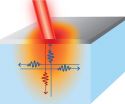(Press-News.org) Psychiatry researchers from the University of Adelaide have developed a model that could help to predict a patient's likelihood of a good outcome from treatment - from their very first psychotic episode.
The model is based on a range of factors, including clinical symptoms, cognitive abilities, MRI scans of the brain's structure, and biomarkers in the patient's blood.
Speaking in the lead up to World Mental Health Day (10 October), the University's Head of Psychiatry, Professor Bernhard Baune, says the model is a revolutionary idea for psychiatric care, and is aimed at improving treatment for people suffering from mental illnesses such as schizophrenia. He says the model is applicable to other types of mental illnesses as well.
"Being able to predict the trajectory of psychotic illness is a kind of 'holy grail' in psychiatric medicine," says Professor Baune, who is corresponding author of a paper on the new model, to be published in the Australian & New Zealand Journal of Psychiatry. Professor Baune will also present this work at the European Congress of Neuropsychopharmacology in Berlin, Germany this month.
"There is no doubt that our model will be challenging for many in the profession. However, we believe this will improve our understanding of the course of an illness, and lead to a more personalized and specialized approach to the assessment and treatment of people presenting with their first psychotic episode."
Professor Baune says the model builds on a decade of research in this field, and a review and reinterpretation of the relevant studies to date. "Individual illness progression is dependent on a wide range of factors, including sociodemographic, clinical, psychological and biological. These are complex issues, and data on all of them is required in order to model the trajectory of the illness," he says.
"Our model shows that the probability of achieving long-term favorable or unfavorable outcomes can differ significantly depending on the information we have within the first six months of the onset of the disease."
Professor Baune says the use of such a model raises a number of ethical dilemmas: "Should a patient be offered a rigorous treatment right away at the beginning of the disease that, according to current treatment guidelines, is only offered at later stages after years of disease progression? Or should certain treatments be denied if evidence suggests that the course of the illness will be mild or that they will do little for the patient's outcome? These are just some of the questions this work raises, which should be discussed and debated by the profession.
"As with all novel clinical approaches, the use of this model in practice will require rigorous testing. And we would be the first to caution that a tool such as this could ever replace a good quality, empathic treatment relationship with a patient."
INFORMATION:
This research is supported by the National Health and Medical Research Council (NHMRC).
Predicting the future course of psychotic illness
2014-10-01
ELSE PRESS RELEASES FROM THIS DATE:
Fat chats: The good, the bad and the ugly comments
2014-10-01
Cyberbullying and hurtful 'fat jokes' are disturbingly prevalent in the social media environment, especially on Twitter, says Wen-ying Sylvia Chou of the National Institutes of Health in the US. Chou is lead author of a study in Springer's journal Translational Behavioral Medicine which analyzed well over a million social media posts and comments about weight matters. However, the researchers were also happy to find that the news was not all bad: many instances of support and advice were also observed, especially on blogs and forums.
The study is one of the first to analyze ...
Fall in monsoon rains driven by rise in air pollution, study shows
2014-10-01
Emissions produced by human activity have caused annual monsoon rainfall to decline over the past 50 years, a study suggests.
In the second half of the 20th century, the levels of rain recorded during the Northern Hemisphere's summer monsoon fell by as much as 10 per cent, researchers say. Changes to global rainfall patterns can have serious consequences for human health and agriculture.
Scientists found that emissions of tiny air particles from man-made sources – known as anthropogenic aerosols – were the cause. High levels of aerosols in the atmosphere cause heat ...
Wild ducks take flight in open cluster
2014-10-01
Messier 11 is an open cluster, sometimes referred to as a galactic cluster, located around 6000 light-years away in the constellation of Scutum (The Shield). It was first discovered by German astronomer Gottfried Kirch in 1681 at the Berlin Observatory, appearing as nothing more than a fuzzy blob through the telescope. It wasn't until 1733 that the blob was first resolved into separate stars by the Reverend William Derham in England, and Charles Messier added it to his famous catalogue in 1764.
Messier was a comet hunter and the catalogue came into being as he was frustrated ...
Gene interacts with stress and leads to heart disease in some people
2014-10-01
DURHAM, N.C. – A new genetic finding from Duke Medicine suggests that some people who are prone to hostility, anxiety and depression might also be hard-wired to gain weight when exposed to chronic stress, leading to diabetes and heart disease.
An estimated 13 percent of people, all of whom are Caucasian, might carry the genetic susceptibility, and knowing this could help them reduce heart disease with simple interventions such as a healthy diet, exercise and stress management.
"Genetic susceptibility, psychosocial stress and metabolic factors act in combination to increase ...
Results of large-scale roll out of combination treatment for kala-azar in Eastern Africa
2014-10-01
Today in Bahir Dar, Ethiopia, at the occasion of the Leishmaniasis East Africa Platform meeting, which has gathered some 150 African and international leishmaniasis experts, results of a pharmacovigilance – or large-scale treatment safety and efficacy monitoring – plan, carried out by MSF, DNDi, and national partners in Kenya, Sudan, Uganda, and Ethiopia, were presented to key decision makers in order to boost patient access to treatment of kala-azar with the combination of Sodium Stibogluconate and Paromomycin (SSG&PM) in the region. In this large cohort of patients, treated ...
Long-acting insulin is safer, more effective for patients with Type 1 diabetes
2014-10-01
TORONTO, Oct. 1, 2014 – Long-acting insulin is safer and more effective than intermediate-acting insulin for patients with Type 1 diabetes, according to new research published in the BMJ.
Researchers looked at once-daily and twice-daily doses of both long- and intermediate-acting insulin, ranking their effectiveness, safety and cost-effectiveness.
"In patients with Type 1 diabetes, we found that long-acting insulin is superior to intermediate-acting insulin when it came to controlling blood sugar, preventing weight gain and treating severe hypoglycemia," said Dr. ...
All directions are not created equal for nanoscale heat sources
2014-10-01
Thermal considerations are rapidly becoming one of the most serious design constraints in microelectronics, especially on submicron scale lengths. A study by researchers from the University of Illinois at Urbana-Champaign has shown that standard thermal models will lead to the wrong answer in a three-dimensional heat-transfer problem if the dimensions of the heating element are on the order of one micron or smaller.
"As materials shrink, the rules governing heat transfer change as well," explained David Cahill, a professor of materials science and engineering at Illinois. ...
Microbes in Central Park soil: If they can make it there, they can make it anywhere
2014-10-01
Soil microbes that thrive in the deserts, rainforests, prairies and forests of the world can also be found living beneath New York City's Central Park, according to a surprising new study led by Colorado State University and the University of Colorado Boulder.
The research team analyzed 596 soil samples collected from across Central Park's 843 acres and discovered a stunning diversity of below-ground life, most of which had never been documented before.
Only 8.5 percent to 16.2 percent of the organisms discovered in the park soils, depending on their type, had been ...
Non-citizens face harsher sentencing than citizens in US criminal courts
2014-10-01
WASHINGTON, DC, September 29, 2014 — Non-Americans in the U.S. federal court system are more likely to be sentenced to prison and for longer terms compared to U.S. citizens, according to a new study.
"Much of the discussion in this area has centered around deportation, but increasing numbers of immigrants are being brought before criminal courts, and little is known about how they are treated once they are in the criminal justice system," said Michael T. Light, an assistant professor of sociology at Purdue University and the lead author of the study. "This is a major ...
Immunotherapy could stop resistance to radiotherapy
2014-10-01
Treating cancers with immunotherapy and radiotherapy at the same time could stop them from becoming resistant to treatment, according to a study published in Cancer Research* today (Wednesday).
The researchers, based at The University of Manchester and funded by MedImmune, the global biologics research and development arm of AstraZeneca, and Cancer Research UK, found that combining the two treatments helped the immune system hunt down and destroy cancer cells that weren't killed by the initial radiotherapy in mice with breast, skin and bowel cancers.
Radiotherapy ...



